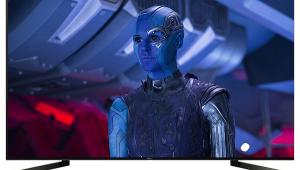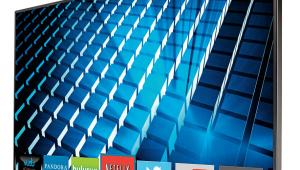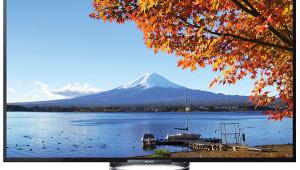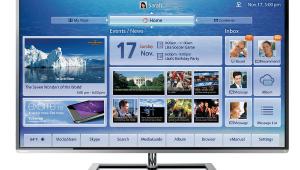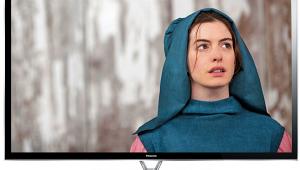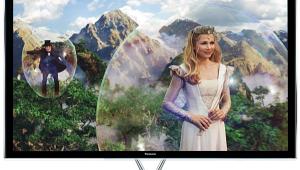Samsung 77" S95D Quantum Dot OLED TV Review
AT A GLANCE
Plus
Ultra bright picture for an OLED display
Wide natural color gamut coverage
Impressive matte anti-reflective screen
Low input lag and high refresh rate for gaming
Minus
No ATSC 3.0 NextGen TV tuner
Slight blooming from anti-glare technology
No Dolby Vision HDR
No Google Assistant voice support
THE VERDICT
This series greatly improves Quantum-OLED tech's brightness game. It has an excellent reflection-reducing screen that sets it apart from other Quantum OLEDs we've seen. It's worth the extra cost over a 2023 S95C close-out. But you will likely find a better deal if you wait for key sales events later in the year.
Clicks on our links may earn us a commission. Thank you for your support.
Samsung's 77-inch QN77S95D TV is the third version of its OLED TVs, which combine quantum dots and blue OLED light. This technology is called "Quantum-OLED" by Samsung Electronics and "QD-OLED" by Samsung Display, the company that makes the screens. It uses quantum dots to change blue OLED light to red and green light for its RGB pixels.
.jpg)
This year's version delivers one of the brightest 4K UHD HDR10 pictures (topping 1600 nits in a 10% window pattern) we've tested from a consumer OLED television to date. The higher luminosity is brilliant against a new matte black anti-glare screen that nearly eliminates room reflections.
Features
The set has a thin panel (0.43 inches deep) design and an outboard One Connect Box. Using the supplied stand allows the set to fit against a wall or stand neatly without cable clutter on a credenza or entertainment center.
.jpg)
The Samsung 77S95D has many powerful picture and sound processing tools. They are driven by Samsung's latest "Neural Quantum" NQ4 AI Gen 2 Processor. This setup offers advanced upscaling and noise reduction. The AI technology lets users configure the television to automatically adjust the picture and sound. It does this by changing the picture to match the room's light and the type of content. However, we found the picture mode presets, like Filmmaker Mode, to be better for most movie viewing. They are more consistent in preserving the artistic vision.
When not in use for movies or TV, the Samsung S95D is an exceptional 4K OLED gaming display. It has up to a 144Hz refresh rate, which creates smooth, clear, and fast gameplay for advanced game titles. This speed is available on any of the four HDMI 2.1 inputs. The set's Motion Xcelerator 144Hz processing offers smooth motion and clear gaming action. It works with advanced consoles and gaming PCs.
.jpg)
Unfortunately, no display is perfect. After offering many 4K NextGen TVs last year, Samsung has only put new ATSC 3.0 tuners in its 8K models this year. We weren't given a reason for this omission. However, Samsung has quietly followed the path of its rival LG Electronics. They are cutting their use of these tuners as broadcasts become more available. LG previously announced it is dropping ATSC 3.0 tuners from all its 2024 models due to an IP-licensing dispute.
If you want ATSC 3.0 capability in a new OLED TV, we suggest you consider getting one of the 2023 Samsung S95C Quantum OLED models or wait to see what Sony brings to market soon. Alternatively, you can purchase a third-party NextGen TV set-top tuner box outfitted with new Digital- Rights Management (DRM) support for about $100 on the low end.
Design
Just as in last year's S95C series, Samsung has kept the design of the 77S95D cabinet and bezel thin and minimal. The panel measures just 0.43 inches deep. When looking straight on, the design has a nearly bezel-free look. Only a slim border trim runs along the sides and top of the screen. Samsung supplies a sturdy metal pedestal stand that can be used to mount a supplied One Connect box hidden behind the screen.
Alternatively, you can use a single proprietary connection cable to position the box off to the side of or under the display. The One Connect box houses the display circuitry, power, and input connections. It provides a neat solution for device input management when installed on a wall using an optional VESA-standard thin-profile bracket.
The One Connect box has all the in/out ports. It includes four HDMI 2.1 (one supports eARC/ARC), three USB ports, one ethernet port, an optical audio output, an RS-232C port, an antenna/cable connector, and a proprietary port for the One Connect cable. The cable handles power and input signals. The 77-inch 77S95D screen measures 67.5 inches wide, 0.43 inches deep (11.2 inches with stand), and 38.7 inches high (42.1 inches with stand).
The S95D continues to use Samsung's SolarCell Remote, a slim wand-style controller with a built-in rechargeable battery. It has a small solar panel on the back to gather sun or room light. If you put it down with the panel side up, it keeps a charged battery. Users can also connect the controller to a USB-C cable charger. As with previous years, users navigate the smart TV app and settings using a large circular directional navigation pad on the control button layout. You can also use voice commands through a button-activated mic. Other buttons include home and playback, along with volume and channel rockers.
Fast access buttons are also included for Amazon Prime Video, Disney+, Netflix, and Samsung TV Plus.
Looking Smart
The compact remote enables easy navigation of the S95D's on-screen menus that make up Samsung's Tizen 8.0 smart TV experience. This year, Samsung's Gen 2 AI processor has made the interaction a little snappier.
In addition to the push-button mic on the remote, the television provides voice control using far-field mics. Users can set it up to work with Samsung's own Bixby voice control platform or Amazon Alexa. Samsung no longer supports Google Assistant.
This year's Tizen OS also adds a new Sub Tab row with "For You," "Live" and "Apps" categories positioned across the bottom home screen. The For You tab contains recommended media, game, and art content determined by viewing preferences. Live offers a menu of broadcasts, streamed content. Apps recommends apps that it thinks could be interesting based on the active user's profile.
The Tizen OS platform continues to offer a large app library loaded with the most popular streaming video, music, and gaming apps. The smart TV interface provides dynamic ribbons of screen thumbnails. They show content from desired apps that best match a viewer's preferences. In addition, the platform supports several smart home platforms and devices through Samsung SmartThings and Apple AirPlay 2 protocols. Users can also buy an aftermarket USB camera for video calls. It has multi-view features to show multiple callers on screen at once.
Various health and fitness apps can also use Multi-View to consult with professionals who can track progress and provide instructions.
Performance
To fully leverage the significant panel brightness, the Samsung S95D series supports high dynamic range (HDR) content through the HDR10, HDR10+ (adaptive and gaming), and hybrid log gamma (HLG) profiles. But Samsung continues to eschew Dolby Vision support. Most viewers shouldn't find this a deal breaker, however, as the dynamic Dolby Vision metadata cues are seamlessly translated to static HDR10 form to produce similarly bright, dark, and colorful HDR lighting elements. These aren't continuously adjusted on a scene-by-scene basis as the full Dolby Vision profiles provide. Still, most viewers are unlikely to notice the difference without a side-by-side comparison.
The TV also delivers great dynamic metadata HDR performance when playing content graded for the HDR10+ HDR profile. HDR10+ content is becoming increasingly available from both streaming and physical media sources, which means that support for this technology is becoming more important than ever before.
We tested the 77S95D's brightness with a Portrait Displays C6-HDR colorimeter. We also used a Murideo SIX-G signal generator and Portrait Displays’ latest Calman software. We did the testing at Samsung’s QA lab in Pine Brook, New Jersey. Our time was somewhat limited, so we focused on content and test patterns that we felt were most important or most improved from a year ago.
The 2024 Quantum OLED panel achieved a peak HDR10 brightness of an impressive 1669 nits. This measurement was taken inside a 10% D65 (natural sunlight) white window pattern, with picture settings manually set to Filmmaker Mode. This represents a remarkable achievement for OLED display technology, which for years struggled to achieve brightness levels close to 1000 nits. The new measurement was nearly 400 nits higher than the measurement taken for last year's S95C series, and the difference was immediately noticeable. When measuring across multiple window patterns, the set quickly ramped down from the 10% window pattern to 300 nits for a 100% full white screen pattern.
This rapid reduction in brightness is likely a safety measure to protect the screen from image retention damage, a potential hazard in OLED technology. We did not attempt to deliberately test the panel's sensitivity limits at these higher brightness levels. However, we recommend exercising caution by not leaving bright static images on any OLED screen for extended periods. This precaution should not be a significant concern if you're attentive and avoid leaving the TV on static displays for long periods of the day.
The black level was nearly zero nits in Filmmaker mode, as we would expect from an OLED screen. But, when we ran a moving starfield test pattern from the Spears & Munsil UHD HDR test disc, we saw a small amount of raised haloing (or blooming) around bright star clusters. This appeared as faint milky halos around clumps of stars moving across the screen. We do not expect to see this from an OLED display because the starfield pattern was designed to showcase the lack of blooming, which is one of OLED technology's key strengths. We attribute this to the new anti-glare coating in the panel. Fortunately, the issue was not apparent in real-world content tests, and we don't expect it to be a significant distraction in most scenarios. We also noticed a slight crushing of fine shadow detail.
In very dark scenes, such as the night-time evil wizard army attack in Harry Potter & The Deathly Hollows Vol. 2 from the SD 1080p Blu-ray disc, we found traces of the swirling background mist to be mostly crushed by the dark surrounding hills, though some detail was still present. On the other hand, there was no evidence of the black blob that briefly appeared in some earlier 4K full array LED-LCD models with local dimming.
Both SDR and HDR color reproduction was excellent, with the UHDA target pattern for the HDR10 DCI-P3 wide color gamut recommendation measuring a nearly perfect 99.97% of both the xy and uv P3 gamut patterns in Portrait Display's Calman. Just for grins, we also measured the aspirational BT.2020 wide color gamut and found a similarly excellent 84.49% xy and 89.48% uv coverage reading. These are among the widest color performance levels we've tested from an OLED display.
The Samsung 77-inch 77S95D used for this review was provided for us on site at Samsung's New Jersey QA Lab. We used our own test equipment and demonstration materials using a range of settings. We didn't have time to run a full calibration on this model, and the review sample could have benefited from a multipoint grayscale adjustment at the brighter end of the range. However, we discovered that the out-of-box EOTF and brightness closely matched the recommended test patterns for HDR. This shows that the light levels matched the filmmaker's artistic intention and industry standards.
Where color shades lie outside of the S95D's coverage range, Samsung continues to feature its Tone Mapping technology that nicely adjusts shades beyond the coverage range. For the most part, this didn't look unnatural or distracting. Still, it was rarely necessary, as real-world images and flesh tones were realistically vibrant for both HDR and SDR without the need for further embellishments. This year, Samsung has improved color mapping. It uses AI technology to analyze and present more natural-appearing colors, particularly in skin tone subtleties.
Motion
The Samsung S95D supports up to a 144Hz refresh rate for gaming content, an excellent feature for advanced gameplay when compatible titles are available. For movies, the set manages refresh rates up to 4K 120Hz. However, movies shot at higher frame rates might exhibit the 'soap opera effect,' a stylistic choice by some filmmakers.
In Filmmaker Mode, all 'Picture Clarity' settings are automatically disabled to align with the original artistic vision, preventing overly sharpened images characteristic of the soap opera effect. But, in this mode, the QD-OLED panel shows a lot of judder. It happens in scenes with a moving camera and vertical objects. For example, forests, fence posts, and stone walls. This was clear in the start of the BBC's 4K Ultra HD Blu-ray of Blue Planet II. The ship's bow railing seemed to stutter behind narrator David Attenborough. This happened when the camera zoomed in from a helicopter shot.
Despite this, the display's few artifacts did not detract from the otherwise brilliant content, as demonstrated by the vivid, sharp, yet natural coral reef sequences that followed, even after adjusting the de-judder settings. The custom setting controls under Picture Clarity allowed us to clear this artifact up entirely without appreciably changing the overall image sharpness. But this nature-based content was intended to look live and vibrant without the need to look particularly cinematic. For most film-based movies, where the look of film is generally desirable, we recommend leaving the set in Filmmaker Mode with the motion controls off.
Uniformity
The Samsung S95D displayed excellent gray screen uniformity, with virtually no dirty screen effect and only a slight pink shift when viewed at an off-center angle. We didn’t detect any static smearing standing out against moving backgrounds during camera pans in scenes from the BBC's Blue Planet II UHD Blu-ray disc, and we attributed the perceived off-angle pink shift more to the reflection of the room’s paint color than to any inherent limitation of the panel. This pink shift wasn’t noticeable in real-world content.
Thanks to the self-emitting nature of OLED technology, the black screen uniformity was nearly perfect. Furthermore, the new matte-screen glare filters introduced no obvious artifacts without an on-screen light source.
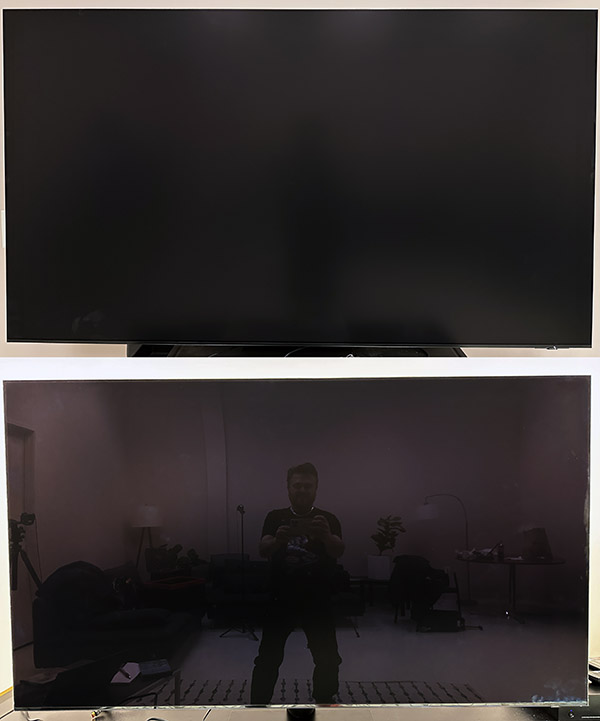
The matte screen (top) is far more effective at eliminating reflections than Samsung's glossy anti-reflective tech (bottom).
Gaming
Like last year's 77S95C, the S95D is an excellent television for gaming. We measured a crazy low 1.9 ms 4K/60p input lag. The set's fast response time produces clear motion graphics with minimal noticeable blur in Game Mode. It supports many advanced gaming features, including variable refresh rate support to reduce tearing. The set has an arsenal of the latest gaming features, starting with the four HDMI 2.1 ports. These are all compatible with this series's four 4K/144 Hz HDR10 gaming signals and FreeSync Premium Pro variable refresh rate.
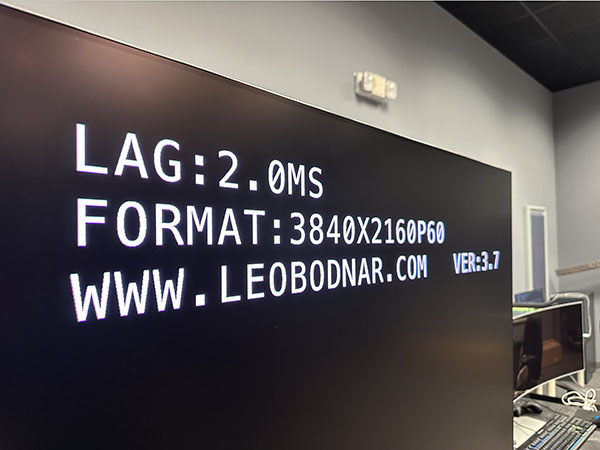
The S95D has virtually no latency.
The set has the obligatory Auto Low Latency Mode (ALLM) to automatically switch into Game Mode upon detection of an incoming game signal, but it now includes an AI Auto Game mode that goes a step further by detecting what genre of game is playing and applying the best picture and sound settings for the particular experience including RPG, FPS, Sports and RTS.
The set is also compatible with HDR Gaming Interest Group (HGiG) protocols assuring streamlined HDR tone-mapping from supported titles.
This year, Samsung added Game Bar 3.0 and Game Hub 4.0 to its premium TVs. A well-laid-out game landing page anchors them. It enables fast access to picture and sound settings. Here, you can make quick tweaks to keep your sights sharpened and competitive in the heat of the action. This is important for current and future capability. It also provides access to many on-board game streaming apps from popular services, useful when a next-gen console or gaming PC isn't enough.
Sound
The S95D's audio system is built with 4.2.2-channel surround sound support and 70 Watts of total power. Drivers are located in the side, bottom, and top of the TV, with a linear array of eight sound ports running across the length of the set's back panel. As last year, the series is compatible with Samsung's Q-Symphony sound integration technology that enables synching the TV's onboard speakers with a similarly configured compatible Samsung sound bar for a full multichannel surround sound experience. This often includes the support of a separate, powered subwoofer and wireless rear-channel speakers, depending on the model selected.
Samsung's Active Voice Amplifier Pro feature enhances voices reproduced by the internal speakers for greater clarity against background sound and ambient room noise. At the same time, Object Tracking Sound+ (OTS+) leverages the TV's built-in multichannel speakers to make the sound dynamics seem to follow objects across the screen and around the listening environment.
Samsung supports True-HD Dolby Atmos for more expansive cinematic surround sound. The built-in sound of the S95D was reasonably full and clear, though the tone was somewhat hollow and directional, which is one of the disadvantages of speakers in thin TV cabinets. The sound clearly reflected off the rear wall behind the set. When spending this kind of money on a home theater experience, we recommend adding a supporting Q-Symphony-enabled sound bar or getting a full multi-channel home theater surround sound setup for the most immersive experience.
Conclusion
Samsung keeps impressing us by stepping up its game in picture and sound performance with its advanced QD-OLED technology. With the enhanced brightness levels and the stunning matte screen design, the Samsung QN77S95D is among the best-looking and highest-performing OLED televisions tested. However, we have yet to test 2024 models from LG and Sony. Although we were disappointed to learn of the company's decision not to include an ATSC 3.0 NextGen TV tuner in 2024 U.S. 4K sets, this year's model surpasses Samsung's 2023 version in many areas.
We wish the small degree of blooming introduced by the glare-reducing filters in an OLED display were eliminated. However, it was better in this regard than virtually any mini-LED LCD TV we've tested. The Samsung 77S95D is a dazzling high-end Quantum-OLED TV. It has very high brightness, top-notch color, and minimal input lag. It should please movie lovers, gamers, sports fans, and anyone who likes a top-notch TV.
.jpg)
HDR10 peak luminance measured across window size patterns show 1669 nits at 10% D65 in Portrait Display’s Calman evaluation software.
.jpg)
The Samsung S95D demonstrated nearly perfect HDR10 P3 wide color gamut coverage in Portrait Displays Calman evaluation software.
.jpg)
Out-of-the-box HDR10 grayscale showed near perfect EOTF and luminance tracking in Portrait Display’s Calman evaluation software.
We thank the folks at Portrait Displays who make Calman software for providing essential resources that enrich Sound & Vision TV reviews.
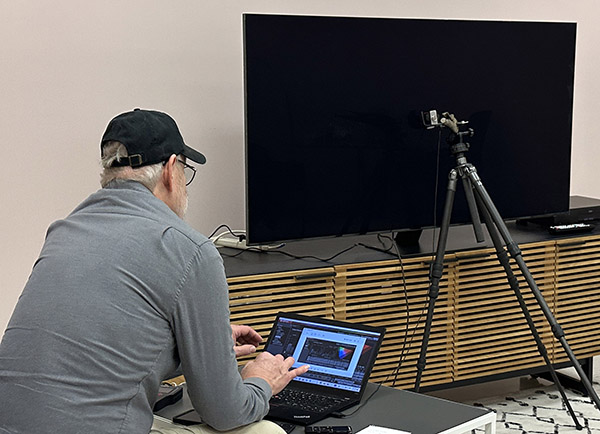
Specs
Dimensions
Set Size with Stand: 67.6 x 41.3 x 11.3 (WxHxD)
One Connect Box: 14.2 x 1.3 x 13 (WxHxD)
Weight
Set Weight without Stand (lb): 62.2
Set Weight with Stand (lb): 88.2
Video Inputs
4X HDMI 2.1 (with eARC)
Audio
4.2.2 Ch, Dolby Atmos, OTS+, Adaptive Sound Pro


